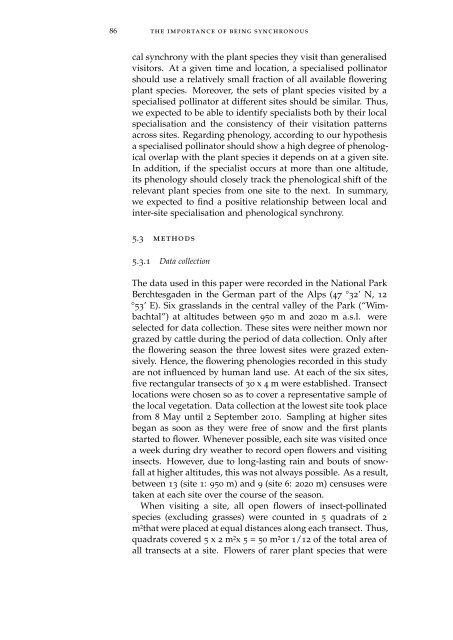Linking Specialisation and Stability of Plant ... - OPUS Würzburg
Linking Specialisation and Stability of Plant ... - OPUS Würzburg
Linking Specialisation and Stability of Plant ... - OPUS Würzburg
Create successful ePaper yourself
Turn your PDF publications into a flip-book with our unique Google optimized e-Paper software.
86 the importance <strong>of</strong> being synchronous<br />
cal synchrony with the plant species they visit than generalised<br />
visitors. At a given time <strong>and</strong> location, a specialised pollinator<br />
should use a relatively small fraction <strong>of</strong> all available flowering<br />
plant species. Moreover, the sets <strong>of</strong> plant species visited by a<br />
specialised pollinator at different sites should be similar. Thus,<br />
we expected to be able to identify specialists both by their local<br />
specialisation <strong>and</strong> the consistency <strong>of</strong> their visitation patterns<br />
across sites. Regarding phenology, according to our hypothesis<br />
a specialised pollinator should show a high degree <strong>of</strong> phenological<br />
overlap with the plant species it depends on at a given site.<br />
In addition, if the specialist occurs at more than one altitude,<br />
its phenology should closely track the phenological shift <strong>of</strong> the<br />
relevant plant species from one site to the next. In summary,<br />
we expected to find a positive relationship between local <strong>and</strong><br />
inter-site specialisation <strong>and</strong> phenological synchrony.<br />
5.3 methods<br />
5.3.1 Data collection<br />
The data used in this paper were recorded in the National Park<br />
Berchtesgaden in the German part <strong>of</strong> the Alps (47 °32’ N, 12<br />
°53’ E). Six grassl<strong>and</strong>s in the central valley <strong>of</strong> the Park (“Wimbachtal”)<br />
at altitudes between 950 m <strong>and</strong> 2020 m a.s.l. were<br />
selected for data collection. These sites were neither mown nor<br />
grazed by cattle during the period <strong>of</strong> data collection. Only after<br />
the flowering season the three lowest sites were grazed extensively.<br />
Hence, the flowering phenologies recorded in this study<br />
are not influenced by human l<strong>and</strong> use. At each <strong>of</strong> the six sites,<br />
five rectangular transects <strong>of</strong> 30 x 4 m were established. Transect<br />
locations were chosen so as to cover a representative sample <strong>of</strong><br />
the local vegetation. Data collection at the lowest site took place<br />
from 8 May until 2 September 2010. Sampling at higher sites<br />
began as soon as they were free <strong>of</strong> snow <strong>and</strong> the first plants<br />
started to flower. Whenever possible, each site was visited once<br />
a week during dry weather to record open flowers <strong>and</strong> visiting<br />
insects. However, due to long-lasting rain <strong>and</strong> bouts <strong>of</strong> snowfall<br />
at higher altitudes, this was not always possible. As a result,<br />
between 13 (site 1: 950 m) <strong>and</strong> 9 (site 6: 2020 m) censuses were<br />
taken at each site over the course <strong>of</strong> the season.<br />
When visiting a site, all open flowers <strong>of</strong> insect-pollinated<br />
species (excluding grasses) were counted in 5 quadrats <strong>of</strong> 2<br />
m²that were placed at equal distances along each transect. Thus,<br />
quadrats covered 5 x 2 m²x 5 = 50 m²or 1/12 <strong>of</strong> the total area <strong>of</strong><br />
all transects at a site. Flowers <strong>of</strong> rarer plant species that were
















